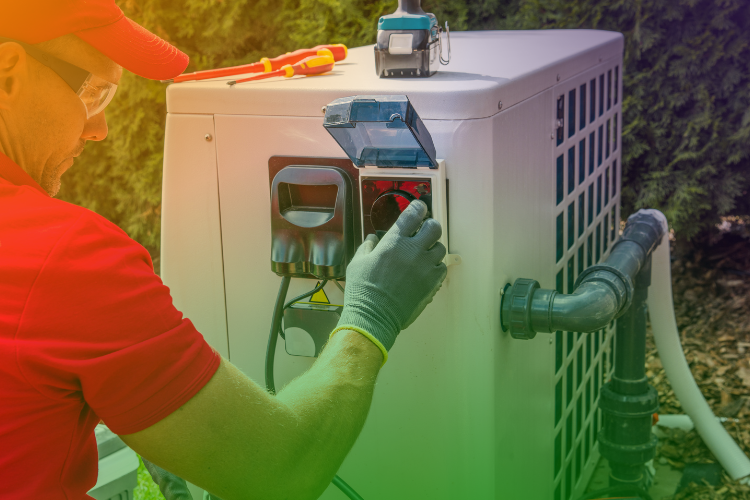The cost of a ground source heat pump (GSHP) in the UK can vary depending on a number of factors such as the size of the system, the depth and area of the ground loop, and the complexity of the installation. In general, the cost of a GSHP system can range from around £10,000 to £25,000 or more for a typical residential installation, including installation costs. However, the cost can vary significantly depending on the specific requirements of the installation. It's important to consult with a qualified GSHP installer to get an accurate cost estimate based on your individual circumstances. Additionally, it's worth noting that GSHP systems can provide significant savings on energy bills over time, making them a cost-effective and environmentally-friendly heating solution in the long run.
What is a ground source heat pump?
A ground source heat pump (GSHP) is a renewable heating system that extracts heat from the ground and uses it to provide heating and hot water for homes and buildings. The system works by circulating a mixture of water and antifreeze through a buried ground loop, which absorbs heat from the ground. This heat is then transferred to a heat exchanger in the heat pump unit, where it is used to heat the air or water that is distributed throughout the building. The system can also be used to provide cooling during hot weather by reversing the process and extracting heat from the building and depositing it into the ground. GSHPs are highly efficient and can provide significant savings on energy bills compared to traditional heating systems. They also have a long lifespan and require relatively little maintenance once installed. However, installation costs can be higher than other heating systems due to the need for burying the ground loop, and it's important to ensure that the ground conditions are suitable for installation.
What are the different types of ground source heat pumps?
There are two main types of ground source heat pumps (GSHPs):
-
Closed-loop GSHP: This type of system circulates a mixture of water and antifreeze through a network of buried pipes, known as a ground loop. The ground loop can be installed horizontally or vertically, depending on the available space and geology of the site. As the water circulates through the ground loop, it absorbs heat from the surrounding earth and carries it back to the heat pump unit. The heat is then extracted from the water and used to heat the building's air or water supply. The cooled water is then circulated back through the ground loop to absorb more heat.
-
Open-loop GSHP: This type of system uses an underground water source, such as a well or borehole, as a heat source. The water is pumped from the underground source, passed through the heat pump unit, and used to heat the building's air or water supply. The cooled water is then returned to the underground source.
Both closed-loop and open-loop GSHPs can be used for heating, cooling, and hot water production, and can be combined with other renewable energy technologies, such as solar panels and wind turbines, to further reduce energy consumption and carbon emissions.
There are also vertical and horizontal types
Vertical
A vertical ground source heat pump (GSHP) is a type of closed-loop GSHP system that circulates a mixture of water and antifreeze through a network of buried pipes that are installed vertically in the ground. Vertical GSHP systems are typically used when there is limited space available for a horizontal ground loop, or when the ground conditions are unsuitable for horizontal installation.
To install a vertical ground loop, boreholes are drilled into the ground, typically to a depth of 50-100 meters, although the depth can vary depending on the location and the heating requirements of the building. The pipes are then inserted into the boreholes and connected to the heat pump unit. As with all closed-loop GSHP systems, the water circulating through the pipes absorbs heat from the surrounding ground, which is then used to heat the building's air or water supply.
Vertical GSHP systems are often more expensive to install than horizontal systems due to the cost of drilling the boreholes, but they can be more efficient in terms of heat transfer, as the vertical pipes are in contact with a larger volume of earth, which is typically at a more constant temperature than the surface. They also have a smaller footprint, which can be an advantage in urban areas where space is limited.
Horizontal
A horizontal ground source heat pump (GSHP) is a type of closed-loop GSHP system that circulates a mixture of water and antifreeze through a network of buried pipes that are installed horizontally in the ground. The pipes are typically buried at a depth of 1-2 meters, although the depth can vary depending on the location and the heating requirements of the building.
To install a horizontal ground loop, a trench is excavated in the ground and the pipes are laid in a serpentine pattern, with each loop covering an area of around 30-50 meters in length. The pipes are then connected to the heat pump unit. As the water circulates through the pipes, it absorbs heat from the surrounding earth, which is then used to heat the building's air or water supply.
Horizontal GSHP systems are often less expensive to install than vertical systems, as they do not require drilling boreholes. However, they do require a larger area of land than vertical systems, which can be a disadvantage in urban areas where space is limited. The efficiency of a horizontal GSHP system depends on the quality of the soil, as well as the depth and length of the trenches. In general, horizontal GSHP systems are most effective in areas with high thermal conductivity, such as sandy or rocky soils.
How much can you save by installing a ground source heat pump?
The amount of money you can save by adding a ground source heat pump (GSHP) to your home or building depends on several factors, such as the size and type of the system, the cost of electricity or fuel in your area, and the efficiency of your existing heating system.
However, in general, a well-designed and properly installed GSHP system can reduce your heating and cooling costs by up to 70% compared to conventional heating and cooling systems. This is because GSHPs extract heat from the ground, which is a renewable and stable source of energy, rather than relying on fossil fuels or electricity to generate heat.
In addition to energy cost savings, installing a GSHP can also increase the value of your property and improve your overall comfort by providing consistent heating and cooling throughout the year. Furthermore, GSHPs are low-maintenance and have a long lifespan, which can result in additional cost savings over time.
It's important to note that the initial cost of installing a GSHP can be higher than traditional heating and cooling systems, but the long-term energy and cost savings can offset the upfront investment.
Benefits of installing a ground source heat pump
There are several benefits to installing a ground source heat pump (GSHP):
-
Energy Efficiency: GSHPs are one of the most efficient heating and cooling systems available. They can provide up to 70% savings on energy bills compared to traditional heating and cooling systems.
-
Low Carbon Footprint: GSHPs are a low-carbon heating and cooling solution, as they rely on renewable energy from the ground rather than burning fossil fuels.
-
Longevity: GSHPs have a long lifespan of up to 25 years, making them a durable and long-lasting investment.
-
Low Maintenance: GSHPs require minimal maintenance, making them a convenient and hassle-free heating and cooling solution.
-
Space Saving: GSHPs don't require any external units or equipment, making them a space-saving heating and cooling solution.
-
Versatility: GSHPs can be used for both heating and cooling purposes, providing year-round comfort and energy savings.
-
Government Incentives: There are government incentives available in some countries to encourage the installation of GSHPs, such as grants and tax credits.
Overall, installing a GSHP can provide significant energy savings, reduce carbon emissions, and increase the value of your property.
Things to consider when thinking about getting a ground source heat pump installed
Here are some things to consider when thinking about getting a ground source heat pump installed in the UK:
-
Property suitability: Ground source heat pumps require a certain amount of space to be installed, both inside and outside the property. The ground conditions and type of soil will also affect the suitability of the property for a GSHP.
-
Installation costs: The installation costs of a GSHP can be higher than traditional heating systems, but the long-term savings in energy bills can offset these costs.
-
System size: The size of the GSHP system will depend on the size of the property and the heating and cooling demands. It's important to choose the right size to ensure efficient operation and maximum energy savings.
-
Heating and hot water requirements: GSHPs can provide both heating and hot water, but it's important to consider the hot water demands of the property and whether a separate hot water cylinder is required.
-
Maintenance requirements: GSHPs require minimal maintenance, but it's important to consider the annual servicing costs and any repairs that may be required.
-
Government incentives: There are government incentives available in the UK to encourage the installation of GSHPs, such as the Renewable Heat Incentive (RHI), which provides financial support for eligible installations.
-
Installer qualifications: It's important to choose a qualified and experienced installer to ensure the GSHP is installed correctly and efficiently.
Overall, a ground source heat pump can provide significant energy savings and environmental benefits, but it's important to consider the suitability of the property, installation costs, system size, and maintenance requirements before making a decision.








